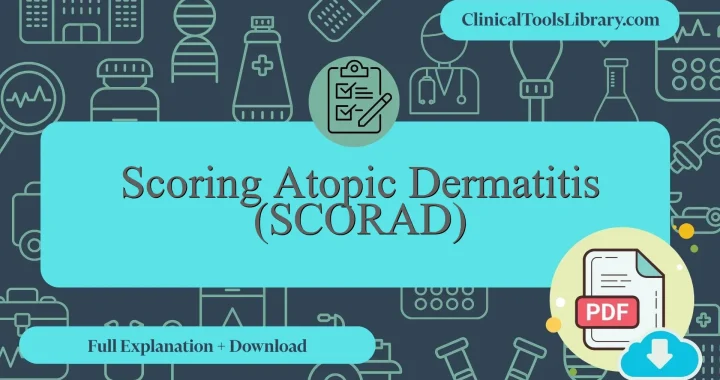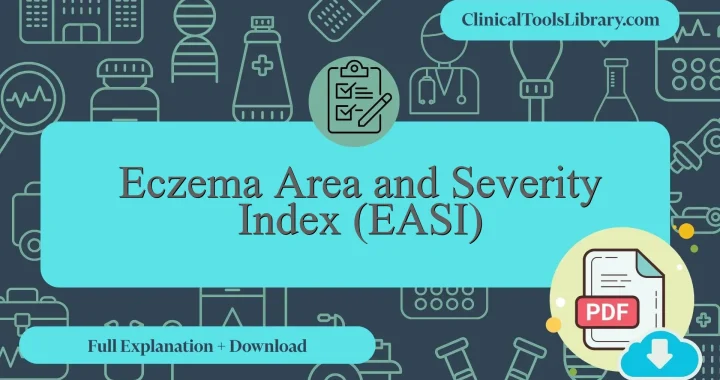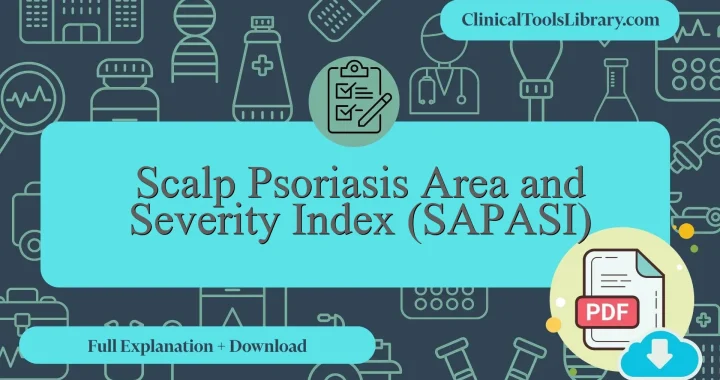In this article, we explain everything you need to know about the Scoring Atopic Dermatitis (SCORAD). We will cover the aspects it evaluates, the target population, a detailed step-by-step explanation, and how to interpret its results. Additionally, we will dive into the scientific evidence supporting this tool (diagnostic sensitivity and specificity) in clinical assessment. You will also find official and unofficial sources available for download in PDF format.
What does the Scoring Atopic Dermatitis (SCORAD) assess?
The Scoring Atopic Dermatitis (SCORAD) is a validated atopic dermatitis assessment tool designed to quantify the severity of atopic dermatitis by evaluating both the extent and intensity of skin lesions. It combines objective clinical signs such as erythema, edema/papulation, oozing/crusts, excoriation, lichenification, and dryness with subjective symptoms including pruritus and sleep loss. The SCORAD calculator facilitates standardized measurement through a composite score, enhancing the reliability of severity assessment. This tool is frequently used alongside other atopic dermatitis scales like the EASI score and the IGA score atopic dermatitis calculator to provide a comprehensive evaluation. Additionally, the SCORAD PDF and variants such as PO-SCORAD assist clinicians in practical settings, enabling consistent application and monitoring of disease progression. The method incorporates how to calculate BSA for atopic dermatitis to determine the affected body surface area, contributing to an accurate severity index.
For which type of patients or populations is the Scoring Atopic Dermatitis (SCORAD) intended?
The SCORAD index is primarily indicated for patients diagnosed with atopic dermatitis, including both pediatric and adult populations exhibiting varying severity levels. It is most useful in clinical settings for standardized assessment of disease extent and intensity, facilitating objective comparison over time and response to treatment. The tool integrates both physician-reported signs and patient-reported symptoms, providing a comprehensive overview that complements other atopic dermatitis assessment tools such as the EASI score and IGA score. Utilization of the SCORAD calculator or reviewing the SCORAD PDF guidelines aids clinicians in quantifying clinical severity accurately, which is essential for monitoring therapeutic outcomes and guiding management decisions in both routine practice and clinical trials.
Step-by-Step Explanation of the Scoring Atopic Dermatitis (SCORAD)
The Scoring Atopic Dermatitis (SCORAD) index is a validated tool used to assess the severity of atopic dermatitis based on three components. It consists of 6 objective items evaluating the extent of affected skin, determined by the “rule of nines,” and 6 items assessing the intensity of clinical signs such as erythema, edema/papulation, oozing/crusts, excoriation, lichenification, and dryness. Each sign is scored on a 0 to 3 scale, where 0 indicates absence and 3 denotes severe manifestation. Additionally, the tool includes 2 subjective questions addressing pruritus and sleep loss, rated on a visual analog scale (VAS) from 0 to 10. The final SCORAD score is calculated by combining the extent (0–100), intensity (maximum 18), and subjective symptoms (maximum 20), following the formula: A/5 + 7B/2 + C, yielding a total score ranging from 0 to 103 points, reflecting disease severity objectively and comprehensively.
Downloadable SCORAD PDF: Atopic Dermatitis Assessment Tools & Calculator in English & Original
Downloadable resources are available below, offering both the original and English versions of the Scoring Atopic Dermatitis (SCORAD) in PDF format. These materials serve as essential atopic dermatitis assessment tools, facilitating accurate evaluation of disease severity. Healthcare professionals can utilize the SCORAD calculator included within these documents to standardize patient assessments and improve clinical decision-making.
How to interpret the results of the Scoring Atopic Dermatitis (SCORAD)?
The Scoring Atopic Dermatitis (SCORAD) index quantifies the severity of atopic dermatitis by integrating the extent, intensity, and subjective symptoms of the disease. The formula used is: SCORAD = A/5 + 7B/2 + C, where “A” represents the percentage of affected body surface area, “B” corresponds to the intensity score (ranging from 0 to 18), and “C” reflects subjective symptoms such as pruritus and sleep loss (each scored from 0 to 10). Scores range from 0 to 103, with values under 25 indicating mild disease, 25–50 indicating moderate severity, and above 50 classified as severe atopic dermatitis. For healthcare professionals, these stratifications guide treatment decisions and monitor response to therapy, enabling personalized management and prognostic evaluations based on objective data rather than solely clinical impressions.
What scientific evidence supports the Scoring Atopic Dermatitis (SCORAD) ?
The Scoring Atopic Dermatitis (SCORAD) index, developed in 1993 by the European Task Force on Atopic Dermatitis, is a widely recognized clinical tool for assessing the severity of atopic dermatitis. Its validation process involved multicenter studies that demonstrated strong interobserver reliability and responsiveness to clinical changes over time. Numerous peer-reviewed investigations have corroborated its correlation with both objective clinical signs and patient-reported symptoms, such as pruritus and sleep loss. The scoring system integrates extent, intensity, and subjective symptoms, enabling comprehensive disease evaluation. Scientific evidence supports SCORAD’s utility in both clinical trials and routine practice for monitoring disease progression and treatment efficacy in atopic dermatitis management.
Diagnostic Accuracy: Sensitivity and Specificity of the Scoring Atopic Dermatitis (SCORAD)
The Scoring Atopic Dermatitis (SCORAD) index demonstrates a sensitivity ranging from approximately 80% to 90% in identifying disease severity, effectively capturing clinical improvements and exacerbations in patients with atopic dermatitis. Its specificity, while generally high, varies between 75% and 85%, reflecting its reliability in distinguishing atopic dermatitis from other inflammatory skin conditions. These performance metrics support SCORAD’s role as a standardized tool in both clinical practice and research settings, though variations may occur due to evaluator experience and patient heterogeneity.
Related Scales or Questionnaires
The SCORAD index remains a widely used tool for assessing atopic dermatitis severity, but other validated measures such as the EASI score and the IGA score atopic dermatitis calculator offer alternative approaches. The EASI score focuses on the extent and intensity of lesions without patient-reported symptoms, providing objective data yet lacking subjective symptom evaluation, which might limit its comprehensiveness. Conversely, the PO-SCORAD incorporates patient self-assessment but may introduce variability due to subjective reporting. The IGA score is simpler to administer and is frequently used in clinical trials, though it may not capture disease complexity as thoroughly as the SCORAD index. For quantifying affected skin area, methods on How to calculate BSA for atopic dermatitis are crucial and standardized for consistent evaluations. All these scales or questionnaires, including the SCORAD calculator and SCORAD PDF, are explained in detail and available for download on ClinicalToolsLibrary.com, ensuring accessibility for clinical and research use.




